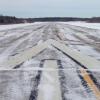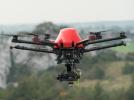Korean A333 near Tianjin on Feb 13th 2013, turbulence injures 2
A Korean Airlines Airbus A330-300, registration HL7710 performing flight KE-805 from Seoul (South Korea) to Tianjin (China) with 235 people on board, was enroute about 187nm short of Tianjin near Beijing when the aircraft encountered turbulence causing serious injuries to two occupants. The aircraft continued to Tianjin for a safe landing at 11:35L (03:35Z).
The French BEA reported in their weekly bulletin South Korea's authorities are investigating the accident.
On Jul 8th 2014 South Korea's ARAIB released their final report in Korean concluding the probable cause of the accident was:
Vortices generated within the strong jet streams, the aircraft was flying in, caused the turbulence encounter. The cabin crew was cleaning the galleys after food service to passengers, two flight attendants fell and received serious injuries.
The ARAIB reported that the aircraft was on approach to Tianjin and was cleared to descend from 8,400 to 7,200 meters (FL275 to FL236). Close to 7,200 meters the aircraft encountered light to moderate turbulence. The captain immediately illuminated the fasten seat belt signs, the seat belt chime was sounded twice. The crew requested further descent and was cleared to 6,600 meters (FL216). The flight smoothened upon reaching 6,600 meters. However, two flight attendants had received serious injuries in the turbulence encounter.
The ARAIB reported that the flight had been planned to cruise at 9,800 meters (FL321), but due to turbulence reports the crew decided in flight to stop the climb and maintain 8,400 meters enroute. The captain (44, ATPL, 7,432 hours total, 992 hours on type) reported the first officer's weather radar was set to 160nm range with a tilt angle between 0.5 and 1.0 degrees nose down. There were no clouds around, however haze was forecast for Tianjin as well as light to moderate turbulence near Tianjin. Light turbulence was encountered on descent first prompting the crew to reduce speed from 310 to 280 KIAS, then moderate turbulence followed prompting the crew to chime the seat belt signs twice turning the seat belt signs on and to request further descent. After the flight became smooth again at FL216 the crew issued a pilot report to ATC.
The first officer (42, ATPL, 13,780 hours total, 2,360 hours on type) reported that about 10-15 seconds after a first light turbulence was felt, the captain immediately illuminated the fasten seat belt signs, moderate turbulence was encountered. The weather charts forecast light to moderate turbulence from FL250 to FL500 south of their flight path.
The weather services reported that there was a haze effect in the area as result of turbulent airflow within two strong jet streams spanning from mainland China across the Yellow Sea into Korea and Japan, however, no cloud, no precipitation and no thunder existed. At the approximate altitude of the aircraft, at FL240, the one jet stream with tops up to FL600 moved at about 110 knots producing moderate turbulence. The other jet stream moved almost parallel at about 90 knots. Within the altitude range of FL200 to FL250 interaction between the two different airflows created moderate turbulence.
The quick access recorder revealed that the aircraft was at 308 KCAS at 23,650 feet when a vertical acceleration of +1.684G was encountered, 6 seconds later another +1.547G, then the amplitude of the bumps reduced and stopped at 21,700 feet.
The ARAIB analysed that the two injured flight attendants were located at the aft galley, one near the door L4 receiving a fracture of the left ankle, the other near the door R4 falling on her back receiving back injuries.
The weather chart of South Korea's Met office (Graphics: ARAIB):
Infrared Satellite Image MTSAT Feb 13th 2013 03:00Z (Photo: MTSAT):
http://avherald.com/h?article=45ea8dbb














Komentarze